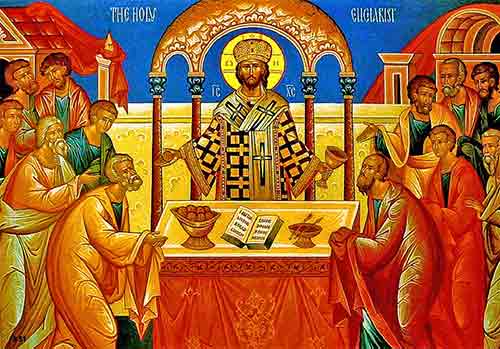
In reflecting on the quality of a Eucharistic Prayer (a Great Thanksgiving), here are some of the things I’m looking out for:
- Clearly a prayer of thanksgiving – consecrating by the community giving thanks (led by the gathered community’s presider) for the great acts of God
- following the Jewish Berakah structure (Praise – Proclaim – Petition – Praise)
- Easily-remembered, consistent responses and acclamations (so preferably poetic and singable) for the gathered community so that they are not focusing on a book (or a projector screen)
- Inclusive and expansive language
- A prayer that flows well, keeps to a consistent tone, and has a broad enough theology to cover acceptable interpretations
Let’s look at Eucharistic Prayers authorised or allowed in the Anglican Church in Aotearoa, New Zealand and Polynesia.
Thanksgiving of the People of God (p. 420)
It’s not a great layout start that the response to “The Lord be with you./Kei konei te Ariki.” (page 420) is on another page.
This is a committee-produced prayer (its history is clearly explained here – see especially p86ff; 101ff; 105ff). The “preface” (section between “…thanks and praise” and “Holy, Holy, Holy…”) is lengthy, intentionally returning to the Eastern tradition of listing God’s mighty acts, rather than the previous Western practice of celebrating a particular event (“proper preface”) alone.
The line, “male and female you created us” has always felt tacked on. It was tacked on. One might argue that this echoes the tacked on feeling in Genesis 1:27
God created humankind in his image,
in the image of God he created them;
male and female he created them.
In the 1980s world of needing to move into gender-inclusive language, it may have appeared a much-needed tacking on. In our world, four decades later, with sensitivity that gender isn’t as binary as we once supposed, the dropping of this line would improve this prayer.
After the Sanctus/Benedictus “Holy, Holy…Blessed…Hosanna in the highest.” In the 1966 form, this prayer continued:
All glory to you, heavenly Father, who in your tender mercy gave your only Son Jesus Christ that all who believe in him might have eternal life…
In the 1970 form this became:
All glory and thanksgiving to you, Holy Father,
because you gave your only son Jesus Christ,
for the sin of the world
that all who believe in him
might have eternal life.
The night before he died on the cross
he took bread…
In 1984, a section was moved from here to a new Eucharistic Prayer. What is left, to me sounds like graunching gears – there’s just no smoothness in this sentence:
All glory and thanksgiving to you, Holy Father;
on the night before he died
your Son, Jesus Christ, took bread…
When the Alternative Great Thanksgiving A was drafted by Rev. Dr. Ken Booth as a revision of this prayer, I made several suggestions. One of my suggestion was to move the acclamation to a point where it progresses the proclaim section into the petition section of the prayer – rather than where it is here (on page 423), concluding the Last Supper story. [Remember, 1662 BCP concludes what it calls the “consecration” at the end of the Last Supper story.]
The prayer concludes with a doxology said by all, an idea introduced by John de la Bere to the 1970 rite, and taken up by other rites internationally. I have a suspicion it connects to Charismatic Renewal days when people spontaneously made the concluding “Amen” more dramatic by joining the priest in the Eucharistic Prayer’s doxology.
The revision, “Alternative Great Thanksgiving A“, was intended to have a longer period of reflection and revision, but that was caught up in the very belated realisation and acknowledgement that the repeated temporary authorisation our Church had long practised is not actually possible under our Constitution.
In the now-authorised revision, “Alternative Great Thanksgiving A“, “Father” occurs once; “Son” thrice; “Lord” seven times (all in the responses/acclamations); “male and female you created us” has gone.
The first “Therefore” is still reducing our response to God’s actions to saying (or singing) words in:
Therefore with the faithful who rest in him,
with angels and archangels and all the company of heaven,
we proclaim your great and glorious name,
forever praising you and singing / saying
I think the “therefore”, in response to God’s actions, should be our actions:
Therefore loving God,
recalling your great goodness to us in Christ,
his suffering and death,
his resurrection and ascension,
and looking for his coming in glory,
we celebrate our redemption with this bread of life
and this cup of salvation.
The graunching gear into the Last Supper story remains:
All glory and thanksgiving to you, holy Father;
on the night before he died your Son,…
To be continued…


